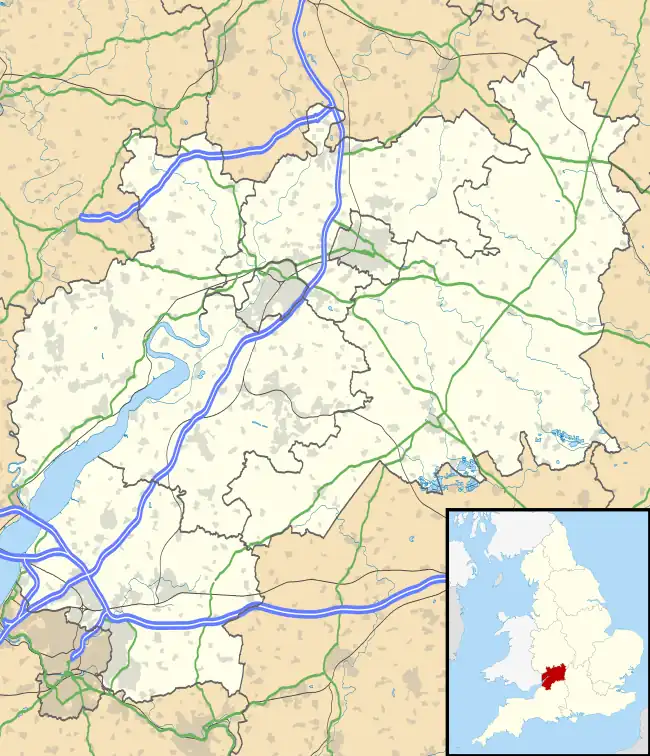| Church of St Andrew | |
|---|---|
.jpg.webp) | |
 Church of St Andrew | |
| 51°52′39″N 1°48′56″W / 51.8776°N 1.8156°W | |
| Denomination | Church of England |
| Architecture | |
| Heritage designation | Grade I listed building |
| Designated | 26 January 1961 |
| Administration | |
| Province | Canterbury |
| Diocese | Gloucester |
| Archdeaconry | Cheltenham |
| Deanery | North Cotswold |
| Benefice | Northleach with Hampnett & Farmington, Cold Aston |
The Anglican St Andrew's Church at Cold Aston in the Cotswold District of Gloucestershire, England was built in the 12th century. It is a grade I listed building.[1]
The Church of England parish church is a Norman church dedicated to St Andrew. Its walls incorporate Saxon stonework and the original church on this site may have been built in around AD 904.[2] David Verey an expert of local architectural history refers approvingly to the "very good" west tower of three stages and other Perpendicular elements of the church, commenting, "All is evidently the work of the best Cotswold masons, and is the fifteenth-century aggrandizement of a Norman church".[3] Much of the present church was restored in 1875.[2]
History
The building was constructed in the 12th century on the site of an earlier church which may have been built in 904.[4] Some of the Saxon stonework has been incorporated into the current fabric of the church.[5]
The church was dedicated to St Mary in the 16th century but was changed to St Andrew by the 18th century.[6] Restoration and repair was carried out in 1820 and the chancel arch rebuilt before 1857. In 1876 a more extensive Victorian restoration was carried out by J. E. K. Cutts.[6]
The parish is part of the benefice of Northleach with Hampnett & Farmington, Cold Aston within the Diocese of Gloucester.[7]
Architecture
The limestone Perpendicular building has a stone slate roof. It consists of a nave, chancel, and porch with a west tower.[1] The tower contains a ring of 5 bells,[8] three of which were cast in 1717.[9]
There are the remains of an Early English pillar piscina in the south wall, while most of the fittings and stained glass are from the 19th century.[1] There is an Easter sepulchre in the north wall.[10]
Within the church is a memorial plaque to villagers who died in World War I and II.[11]
References
- 1 2 3 "Church of St. Andrew". National Heritage List for England. Historic England. Retrieved 8 October 2020.
- 1 2 "Cold Aston Village Church". Official Cold Aston site. 2007. Archived from the original on 29 October 2019. Retrieved 29 October 2019.
- ↑ David Verey, Cotswold Churches (B. T. Batsford Ltd., 1976), at page 193
- ↑ "St Andrew's Church". Cold Aston. Archived from the original on 29 October 2019. Retrieved 8 October 2020.
- ↑ "St Andrew, Cold Aston". Northleach Benefice. Archived from the original on 8 October 2020. Retrieved 8 October 2020.
- 1 2 "Parishes: Cold Aston Pages 9-20 A History of the County of Gloucester: Volume 9, Bradley Hundred. The Northleach Area of the Cotswolds". British History Online. Victoria County History. Archived from the original on 4 August 2020. Retrieved 8 October 2020.
- ↑ "St Andrew". A Church Near You. Church of England. Retrieved 8 October 2020.
- ↑ "Cold Aston, St Andrew". Merrix Eu. Archived from the original on 8 October 2020. Retrieved 8 October 2020.
- ↑ "Cold Aston". Dove's Guide for Church Bell Ringers. Archived from the original on 3 August 2020. Retrieved 8 October 2020.
- ↑ Lees, Hilary (1998). Porch and pew: Small churches of the Cotswolds. Walnut Tree. p. 25. ISBN 978-0948251924.
- ↑ "St Andrews Church tablet WW1 and WW2". Imperial War Museum. Archived from the original on 8 October 2020. Retrieved 8 October 2020.